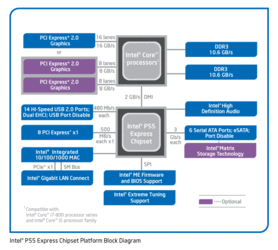Hello, all. I've been contemplating over a new build that would incorporate a high-end single video card and a SATA II (3GB/s) high-end SSD. The research I've done indicates that the 1366 platform benefits from having two PCIe x 16 support versus the 1156's single PCIe x 16. I'd like to understand how this applies to my desired setup.
Ultimately, I don't want to hinder the capabilities of my video card and SSD by having less bandwidth across the PCI-e bus. Do I have a valid concern? I'd like to get some basic background understanding of how all this works if possible. It seems to me that any relatively new video card is listed as a PCIe x 16 2.0 card which would theoretically eat up the entire PCIe bus on a 1156 setup. Of course taking into consideration my resolution would not be higher than 1920 x 1080 does the video card not eat up all that bandwidth?
On the SSD front, how much bandwidth would be left if my SSD were close to it's potential 3GB/s speed? In my mind, in a video game environment the SSD would utilize the PCIe bus for loading the game and then would free most of it back up for the video card to render.
In an attempt to keep this CPU-related, I would go with the i7-930 for the 1366 platform and the i7-860 for the 1156 platform.
Ok, I'm making this question way too long! lol
Ultimately, I don't want to hinder the capabilities of my video card and SSD by having less bandwidth across the PCI-e bus. Do I have a valid concern? I'd like to get some basic background understanding of how all this works if possible. It seems to me that any relatively new video card is listed as a PCIe x 16 2.0 card which would theoretically eat up the entire PCIe bus on a 1156 setup. Of course taking into consideration my resolution would not be higher than 1920 x 1080 does the video card not eat up all that bandwidth?
On the SSD front, how much bandwidth would be left if my SSD were close to it's potential 3GB/s speed? In my mind, in a video game environment the SSD would utilize the PCIe bus for loading the game and then would free most of it back up for the video card to render.
In an attempt to keep this CPU-related, I would go with the i7-930 for the 1366 platform and the i7-860 for the 1156 platform.
Ok, I'm making this question way too long! lol
